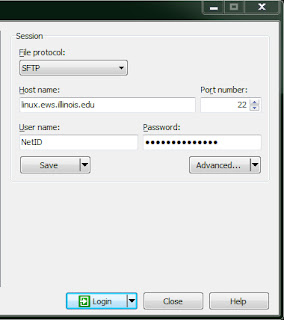How do I connect to a network drive or file share?

Connecting to Linux File Servers from a Linux Computer Using SCP SCP is ideal for quick transfer of single files and directories. Syntax is similar to the Unix copy command. For Connecting to your EWS Home Directory, you can type something like this: scp NetID@linux.ews.illinois.edu :/home/NetID/example.txt /home/localusername/ewsbackup/ If you need to copy an entire directory, you'll need to use the recursive flag, like this: scp -r NetID@linux.ews.illinois.edu :/home/NetID/thisdirectory /home/localusername/ewsbackup/ Connecting to Linux File Servers from Mac OSX For connecting to your Linux Home directories from a Mac OSX please use fugu , which is available for free. Connecting to Linux File Servers from a Windows Computer For connecting to your Linux directories from Windows please use WinSCP, which is available for free. After installing WinSCP you will get the following dialog (WinSCP is installed in the windows labs by default): The hostname is li
